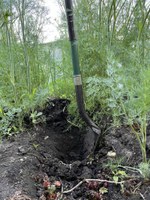Dakota Gardener: Compost overload
(Click an image below to view a high-resolution image that can be downloaded)
By Carrie Knutson, Horticulture Agent
NDSU Extension – Grand Forks County
My garbage bin composting system keeps up with my kitchen waste during the winter and spring. During the summer it is a different story. From faded peony flowers to strawberry hulls from making strawberry jam, the system just can’t keep up with the amount of material.
I use a modified version of pit composting during the summer to help spread out the work. There are many different versions of pit composting.
One version is to dig a hole in the ground about two feet deep and three feet wide. Depending on the amount of space you have, the hole can be any length. If your soil doesn’t pack well, the hole can be lined with bricks, rocks or other rot resistant materials to keep the sides from falling. Then add materials and compost as you normally would. The draw back from this method is it’s a cold and slow composting method that lacks air-movement so the breakdown of the materials will take longer.
There is another pit composting version called trench composting. The NYC Compost Project: Master Composter Manual describes the trench composting process. The idea is to rotate what goes into the trench rows every year.
Year one is compost in a trench, then space to walk and then room for a planting row. The next year would be a plant row in the previous compost trench, then compost in the previous walking space and then room to walk in the previous plant row. The pattern continues and starts over in the fourth year.
I prefer this version because it spreads out the compost in the garden. By the end of my rotations, every section of garden has been amended by compost that I didn’t have to move!
This year, I have enough open space to use the trench method. Some years, it is more of a modified version. Wherever I can find a bare patch of soil, not too close to my vegetables, I dig a hole about 1 foot deep. I layer kitchen waste, some leaves and soil until the hole is filled.
Because the composting is cold and slow, the temperature doesn’t get hot enough to kill seeds. So be aware, that there could be volunteer seedlings next year. Another note of warning is that if you have pets, the composting pits will be fun for pets to dig in and enjoy. A garden fence is a valuable tool to keep not only the bunnies, but pets out too!
Pit composting still follows the same rules as regular composting. Kitchen wastes that are good to put in a composting system would be vegetable and fruit waste, egg shells, tea bags with metal staples removed, coffee grounds and filters. Keep animal waste, weeds with seed heads, meat, dairy and oil products out of the compost pile.
Yard waste, like grass clippings can easily overflow smaller compost systems. To free up space in your bins, use herbicide-free grass clippings as mulch around plants. You can also leave disease-free plant waste on top of your garden as mulch.
For example, my peonies had lots of blooms this year. I didn’t want to fill up my composting systems with the dead blossoms. At the same time, I was battling the weeds under my spruce trees. So, I decided to use the peony blossoms as mulch under the trees. It looks a little unconventional, but so far the peony mulch is holding off the weeds.
Composting kitchen waste and repurposing yard waste reduces the amount of materials that go into our landfills and allows us to return nutrients to the soil so that the nutrients can be used again in the growing cycle. It is a win for everyone. Happy gardening!
NDSU Agriculture Communication – July 12, 2022
Source: Carrie Knutson, 701-780-8229, carrie.knutson@ndsu.edu
Editor: Kelli Anderson, 701-231-6136, kelli.c.anderson@ndsu.edu




